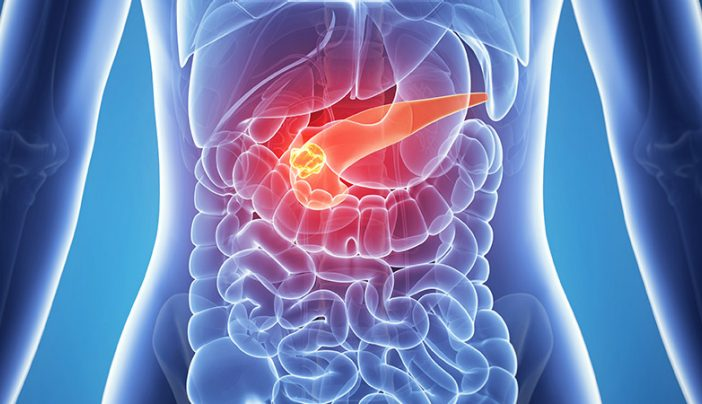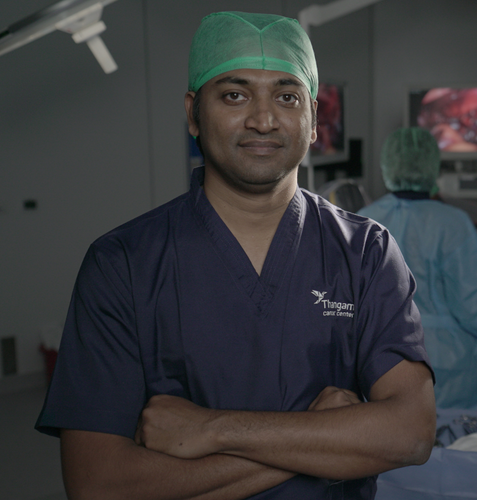Robotic Hepatobiliary and Pancreatic Surgery in India
Surgery is still the best option for a potential cure for pancreatic cancer because it is such an aggressive and deadly disease. In India, pancreatic surgery has evolved significantly thanks to the adoption of cutting-edge methods and tools like robotic surgery, which improve accuracy and lessen patient suffering.
At Thangam Robotic Institute, highly qualified surgeons with extensive experience and skills in minimally invasive techniques undertake pancreatic surgery for cancer patients. Modern facilities and technology at the institute ensure that patients receive the finest care possible. In order to provide comprehensive care, the hospital also features a multidisciplinary staff of oncologists, radiologists, and pathologists.
Because of its dedication to excellence in pancreatic surgery, the institute is a top option for patients looking for top-notch medical care in India.

What is Robotic Hepatobiliary and Pancreatic Surgery
When it comes to hepatobiliary and pancreatic surgery, robotic procedures are among the most effective and rapidly expanding therapy choices. We have top-notch surgeons and cutting-edge technologies at Thangam Robotic Institute to surgically treat complicated cancer situations.

Dr. Saravana Rajamanickam M.S., M.Ch.,
Founder
Specialized Lung & Esophageal Cancer Surgeon
Dr. Saravana Rajamanickam is an authority in the field of thoracic oncology and specialises in the treatment of mediastinal tumours, lung cancer, and esophageal cancer. Oncology is a somewhat uncommon field, and most parts of the nation have few experts in it. In order to lessen the discomfort and difficulties associated with treating such tumours, he is particularly interested in performing surgeries using "minimally invasive" techniques and cutting-edge technologies, including robotics. He is engaged in research to develop new lung cancer treatment plans in addition to his clinical activities.
Read MoreConditions Treated:
Robotic Liver Surgery
The use of robotics in liver surgery enables doctors to carry out complex operations with the potential for increased accuracy, ergonomics, and a three-dimensional perspective of the surgical site. Some of the drawbacks of the laparoscopic procedure can be solved with robotic technology, particularly in the most complicated situations. A better dissection of the hepatic hilum, a fine lymphadenectomy, biliary reconstruction even with short bile ducts, and simpler bleeding management are all made possible by precise dissection and micro suturing, even in small operating fields.
Robotic Hepatectomy
Partial hepatectomy is the surgical removal of a section of the liver and is frequently done in patients with liver cancer. The treatment, which is also known as a liver resection, is designed to remove regions of the liver that have malignant tumours while leaving other liver sections in tact to carry out their regular tasks.
Robotic Segmentectomy
A surgical operation called a segmental resection is used to remove a portion of an organ or gland. To treat malignant growths in the pancreas or liver, this surgery is used.
Robotic Whipple Procedure
In order to treat pancreatic cancer, surgeons perform the Whipple procedure, also known as a pancreaticoduodenectomy, during which portions of the pancreas, small intestine, and gallbladder are removed. When performed with robotic help, this complicated technique is streamlined, more accurate, and recovers more quickly.
Robotic Pancreatectomy
An entire or partial pancreas can be surgically removed during a pancreatectomy. The two most frequent causes of pancreatectomy are tumours and pancreatitis. The danger of a tumour spreading to another part of your body is lowered by removing it from your pancreas. When your pancreas is inflamed, pancreatitis results. Robotic technology keeps the procedure precise and minimally intrusive.
Robotic Hepaticojejunostomy
A hepaticojejunostomy is a surgical procedure used to open up the hepatic duct and the jejunum so that they can communicate. This is typically done when the bile duct is damaged. Comparing robotic hepaticojejunostomy to conventional procedures, it has been found to be a safer procedure.
Robotic Radical Cholecystectomy
The location and potential spread of the malignancy will determine how much surgery is necessary. A prolonged cholecystectomy, at the very least, removes the gallbladder. The liver tissue close to the gallbladder is about an inch or more thick. The recovery is quicker after robotic surgery because it requires a smaller incision and better surgeon support.
FAQ
-
Which signs and symptoms accompany pancreatic cancer?
Abdominal pain, weight loss, loss of appetite, jaundice, and digestive issues are all potential signs of pancreatic cancer.
-
Which surgical procedures can be performed on the pancreas in India?
The Whipple operation, distal pancreatectomy, total pancreatectomy, and laparoscopic surgery are some of the many forms of pancreatic surgery that are offered in India.
-
What is the pancreatic surgery success rate in India?
The success rate of pancreatic surgery is influenced by several variables, including the cancer's stage, the patient's general condition, and the kind of surgery done. However, thanks to improvements in medical technology and surgical methods, pancreatic surgery in India has a high rate of success.
-
How long does pancreatic surgery recovery take?
Depending on the procedure used, different pancreatic surgeries have different recovery times. Most patients can resume their regular activities, nevertheless, in six to eight weeks.
-
What advantages does pancreatic surgery have in India?
In comparison to many other nations, pancreatic surgery in India offers sophisticated surgical treatments employing the most recent tools and technologies. Highly qualified surgeons and medical professionals can provide patients with individualised care.
